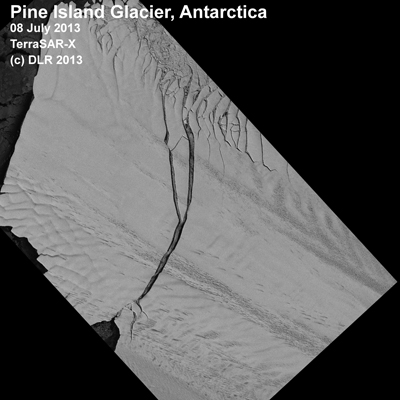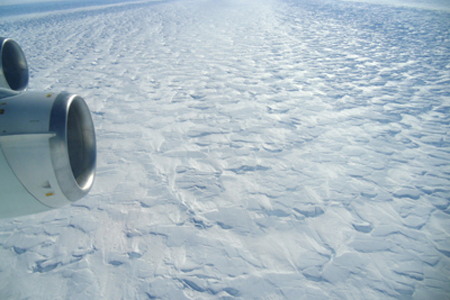Giant Iceberg Breaks Off Antarctic Glacier


A massive iceberg, larger than the city of Chicago, broke off of Antarctica's Pine Island Glacier on Monday (July 8), and is now floating freely in the Amundsen Sea, according to a team of German scientists.
The newborn iceberg measures about 278 square miles (720 square kilometers), and was seen by TerraSAR-X, an earth-observing satellite operated by the German Space Agency (DLR). Scientists with NASA's Operation IceBridgefirst discovered a giant crack in the Pine Island Glacier in October 2011, as they were flying over and surveying the sprawling ice sheet.
At that time, the fissure spanned about 15 miles (24 km) in length and 164 feet (50 meters) in width, according to researchers at the Alfred Wegener Institute for Polar and Marine Research in Bremerhaven, Germany. In May 2012, satellite images revealed a second rift had formed near the northern side of the first crack.
"As a result of these cracks, one giant iceberg broke away from the glacier tongue," Angelika Humbert, a glaciologist at the Alfred Wegener Institute, said in a statement. [Photo Gallery: Antarctica’s Pine Island Glacier Cracks]
Humbert and her colleagues studied high resolution radar images taken by the TerraSAR-X satellite to track the changes in the two cracks, and to observe the processes behind glacier movements.
"Using the images we have been able to follow how the larger crack on the Pine Island Glacier extended initially to a length of 28 kilometers [17 miles]," Nina Wilkens, one of the team researchers from the Alfred Wegener Institute, said in a statement. "Shortly before the 'birth' of the iceberg, the gap then widened bit by bit so that it measured around 540 meters [1,770 feet] at its widest point."
As the Pine Island Glacier retreats and flows out to sea, it develops and drops icebergs as part of a natural and cyclical process, Humbert said. But, the way the ice breaks, or "calves," is still somewhat mysterious.
Get the world’s most fascinating discoveries delivered straight to your inbox.
"Glaciers are constantly in motion," she said. "They have their very own flow dynamics. Their ice is exposed to permanent tensions and the calving of icebergs is still largely unresearched."
The Pine Island Glacier ice shelf, the part of the glacier that extends out into the water, last produced large icebergs in 2001 and 2007.
The glacier is the longest and fastest-changing on the West Antarctic Ice Sheet. While Humbert and her colleagues did not draw direct connections between this week's calving event and climate change, other scientists, including marine geologists at the British Antarctic Survey, are investigating whether global warming is thinning Antarctica's ice sheets and speeding up the glacier's retreat.
Yet, the flow of the Pine Island Glacier may be driven by other factors, Humbert said. The glacier flows to the Amundsen Sea at a rate of about 2.5 miles (4 km) per year. She says whether the flow speeds up or slows down is based more on changing wind directions in the Amundsen Sea, and less by rising air temperatures.
"The wind now brings warm sea water beneath the shelf ice," Humbert said. "Over time, this process means that the shelf ice melts from below, primarily at the so-called grounding line, the critical transition to the land ice."
Still, if the glacier's flow speeds up, it could have serious consequences, the researchers said. The Pine Island Glacier currently acts as a plug, holding back part of the immense West Antarctic Ice Sheet whose melting ice contributes to rising sea levels.
Follow Denise Chow on Twitter @denisechow. Follow OurAmazingPlanet @OAPlanet, Facebook and Google+. Original article at LiveScience's OurAmazingPlanet.

Denise Chow was the assistant managing editor at Live Science before moving to NBC News as a science reporter, where she focuses on general science and climate change. Before joining the Live Science team in 2013, she spent two years as a staff writer for Space.com, writing about rocket launches and covering NASA's final three space shuttle missions. A Canadian transplant, Denise has a bachelor's degree from the University of Toronto, and a master's degree in journalism from New York University.



